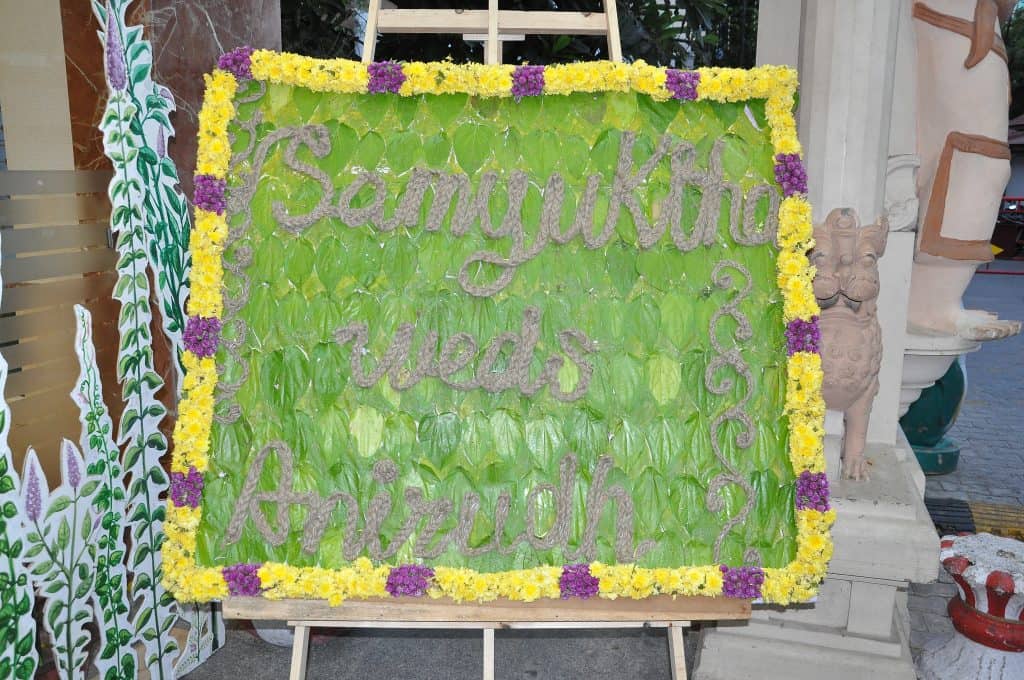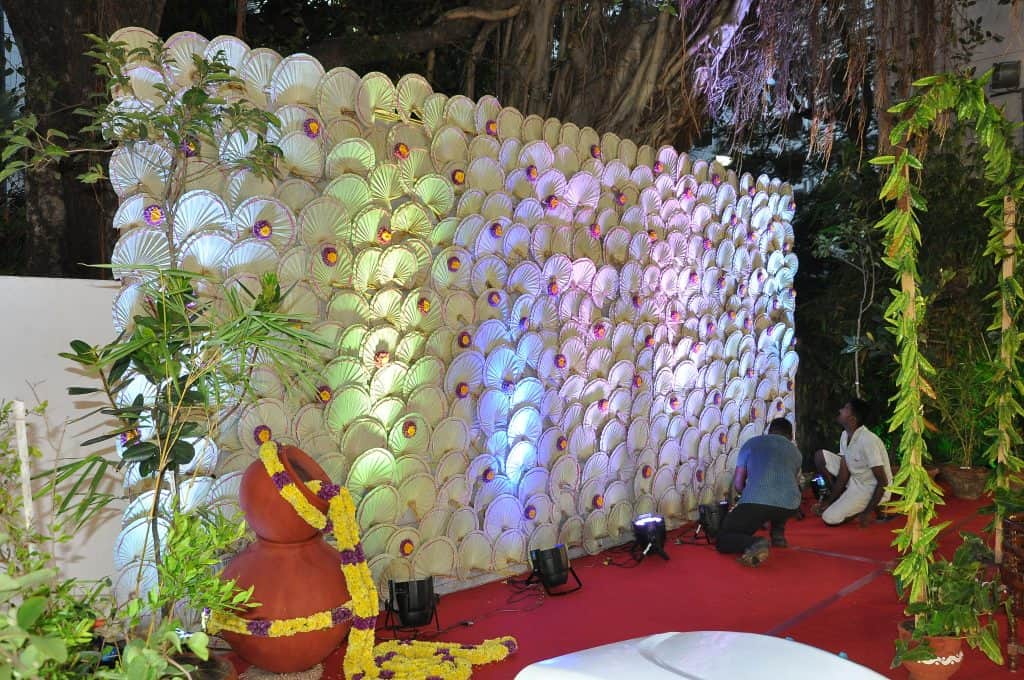The theme for this year’s World Environment Day, celebrated on June 5, was “Beat Plastic Pollution”. Beyond lip service, it is most heartening to witness the deeds of people who walk the talk and show that where there is a will there is a way to ramp up our fight against plastic pollution.
Citizen Matters spoke to one such Chennai citizen, V C Kannan, who, along with his family, has demonstrated that it is indeed possible to go plastic-free, especially at a large event such as a wedding. Yes, a zero-plastic wedding!
The Big Idea
For a family that has always practiced environment consciousness, the decision to have a plastic free wedding was not at all a difficult one. “Conservative consumption, recycling, waste efficiency is a culture at home, and our children were also brought up to appreciate nature,” shares Kannan, who says the idea saw an instant approval with all at home.
From greeting cards to crackers, be it any festive occasion, Kannan always had the habit of taking care to reduce the impact of their celebrations on the environment, to the maximum possible extent. So when it was time to plan the wedding of his daughter, the same habit and practices kicked in, but he went one step ahead to try and aim for a zero waste event.
The bride Samyuktha was naturally inclined to have her wedding reflect the values and beliefs shared by her and her family.
Eye for detail
A wedding with a difference, such as this one, demands great attention to detail. “We started with a checklist, right from invitation planning to the return gift. Getting the vendors like caterers to support in the mission is a critical component”, says Kannan.
Samyuktha, who is an agricultural economist, zeroed in on a Kurinji theme for her wedding as the Kurinji or Mountain theme in literature relates to love between two people. She worked on a painting, flora and fauna describing kurinji, to be printed on the wedding invitation. “We wanted people to retain the painting, so we did not print on it and instead had an overlaid transparent sheet with details of the wedding. The sheet can be removed and the painting can be framed. We printed it in minimum quantity on the eco friendly card and the rest of it was through whatsapp”, says Kannan.
The decor was planned with the theme in mind so naturally the flowers and plants of the kurunji period were part of the decor. Interestingly, the reception evening had the “Visiri” (hand fan made from palm leaf) as the backdrop , the visiri prop was later given away as giveaway to the guests.
No to packaged drinking water
Catering is the single largest source of plastic at a wedding. Packaged drinking water is served at most weddings these days and the half-full bottles are discarded indiscriminately. Food waste was another aspect of the catering that Kannan was determined to minimise.
He had a detailed plan and went the extra mile to ensure that all these common, taken-for-granted habits are broken. “It is all about mindset. We come from a culture of steel tumblers, so why not put that into practice?” questions Kannan who convinced the caterer to do away with the convenience of single use bottles. “It does involve extra labour and adds to the cost. But apart from the fact that the cost of a water bottle might in fact be higher than a tumbler, minimising plastic waste is the great solace here”
From tumblers for water and coffee, to serving the sweets in sugarcane bagasse cups, plastic was done away with completely. The food was served in banana leaf which is degradable, or can be used as cattle feed.
Is our infrastructure ready?
While much of the planning was easy, it was handling of the food waste and kitchen waste that required a lot of attention and involvement of external agencies.
The will to responsibly dispose of the waste efficiently is one thing but do we have enough infrastructure to handle such initiatives is a question that looms large. Kannan ensured that waste disposal and management was just not left to the venue management or catering contractor, as the real challenge of a zero waste wedding lies in going the last mile.
Kripa Ramachandran of Citizen, consumer and civic Action Group (CAG), who supported the zero waste initiative of Kannan’s family, shares the challenges.
“We were very excited to be part of this effort. We planned to get as much of segregation right at the source itself. But there were challenges, as our infrastructure and capacity to handle such wastes at one time, has a long way to go.”
The planning started with mapping the existing infrastructure around the wedding hall to divert the waste. The food waste was taken to the Chennai Corporation’s biogas unit at R A Puram and compost unit at MRC Nagar, and the flowers to the compost unit in Alwarpet. The bio gas unit could not handle the stem of the banana leaf as there was no crusher or shredder in place. The capacity of the biogas units is lesser when it comes to mass handling of waste at one go. These units are operated only once every day. The compost plant could not take the semi liquids and could handle only the vegetable and fruit peels.
“The existing infrastructure either does not work to full capacity or is incapable of processing certain items and that is a big challenge to address” says Kripa, who strongly feels that there should be a intermediary processing facility to enable the processing of bulk waste . She adds that the learnings from helping plan this plastic-free wedding has prompted CAG to create a Bulk Waste Producer directive.
“We worked with the Corporation for the logistics in transporting the waste to the processing centres”, says Kannan. He reiterates that caterers and wedding contractors should keep waste management in mind while planning events like weddings. For those apprehensive about holding such weddings as they fear that the costs may be prohibitive, Kannan assures that with a little bit of planning, the costs will be no higher than a regular wedding and the only difference is the attitude and mindset of the people involved.
As for what the attendees thought of this novel initiative, Kannan adds, “People saw that conducting a plastic-free wedding could be done and that gave us a huge satisfaction”.
A plastic-free wedding checklist
A peek at the checklist prepared for Samyuktha’s wedding helps understand how the use of plastic was entirely eliminated or drastically reduced:
Wedding shopping: Wedding shopping generates plenty of plastic waste, right from the packaging that the clothes and accessories are stored in to the shopping bags that are used after purchase. A way to cut down on plastic at wedding shopping is by having the purchase wrapped in paper covers and cloth bags. Carrying your own suitcase or bag will also come in handy to avoid a large number of plastic covers being accumulated as a result.
Invitation: Invitations that come with plastic overlays and non-recyclable material are guaranteed to be discarded, thereby adding to the waste generation. In order to avoid this, the most viable alternative would ideally be to switch to a digital medium such as e-mail or whatsapp to communicate with the guests. The couple could use social media to keep the guests updated and receive RSVPs for planning. Paper invitations for a small number of guests could be used to ensure plastic is eliminated at this stage.
Decor: Stage and wedding hall decor is also bound to produce a huge quantum of plastic waste if there is no conscious planning to avoid this. Most weddings use flex boards or thermocol to display the names of the couple. This can be avoided by using natural decor as was done at Samyuktha’s wedding by using a betel leaf background and ropes to form letters. The decoration inside the hall can be made plastic-free by avoiding artificial flowers, ribbons or styrofoam. Instead, decor made out of natural products and fresh flowers may be used for an equally appealing and aesthetic look. Avoiding a canopy on the stage and opting for a backdrop made of natural leaves such as palm leaves and the use of potted plants will further ensure elimination of plastic.
Food: Biodegradable cutlery and the use of steel tumblers and banana leaf will reduce the plastic produced at the catering operation. Alternatives include wooden spoons and fork, bagasse cups and areca plates. There are even novel options like edible cutlery made of sugar and wheat that the guests can relish after a meal!
Gifts: Guests demonstrate their affection and good wishes for the couple through gifts. But with this practice comes plastic waste in the form of wrapping paper and packaging material. While this aspect may not be entirely avoided, couples can place requests to the guests to avoid gifts that come with plastic, including bouquets. The return gifts given away by the couple could promote green initiatives by way of giving seeds and potted plants in cloth bags or paper bags.
Citizen Matters staff reporter, Aruna Natarajan, contributed to this story.



Hat’s off to the family for taking such initiative. Hope such alternatives becomes feasible so that it could be adopted by all commons for all occasions including birthdays, get togethers, temple festivals, ….
This is nothing new.it was an age old practice
Awesome.present country need these type of changes. I wish the couple and Mr.kannan and their family is the super family.
With regards
Trailblazer!
Lol….they have used plastic gloves for serving foods. Hence they lost the goal of the plastic free wedding hours.
Fantastic effort
Hats off to Mr Kannan and family.Great effort and planning by them for the zero waste event .Fantastic and a great initiative.Inspiring.